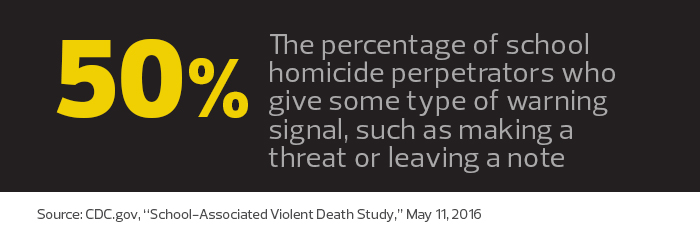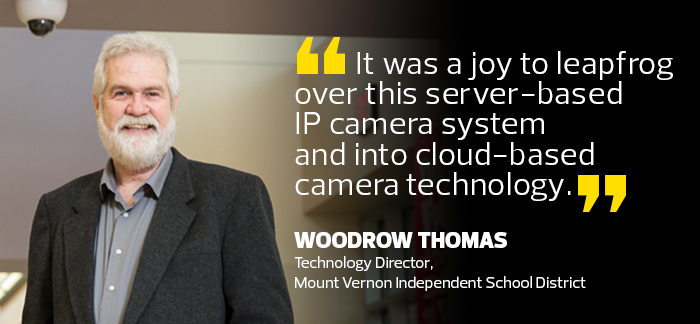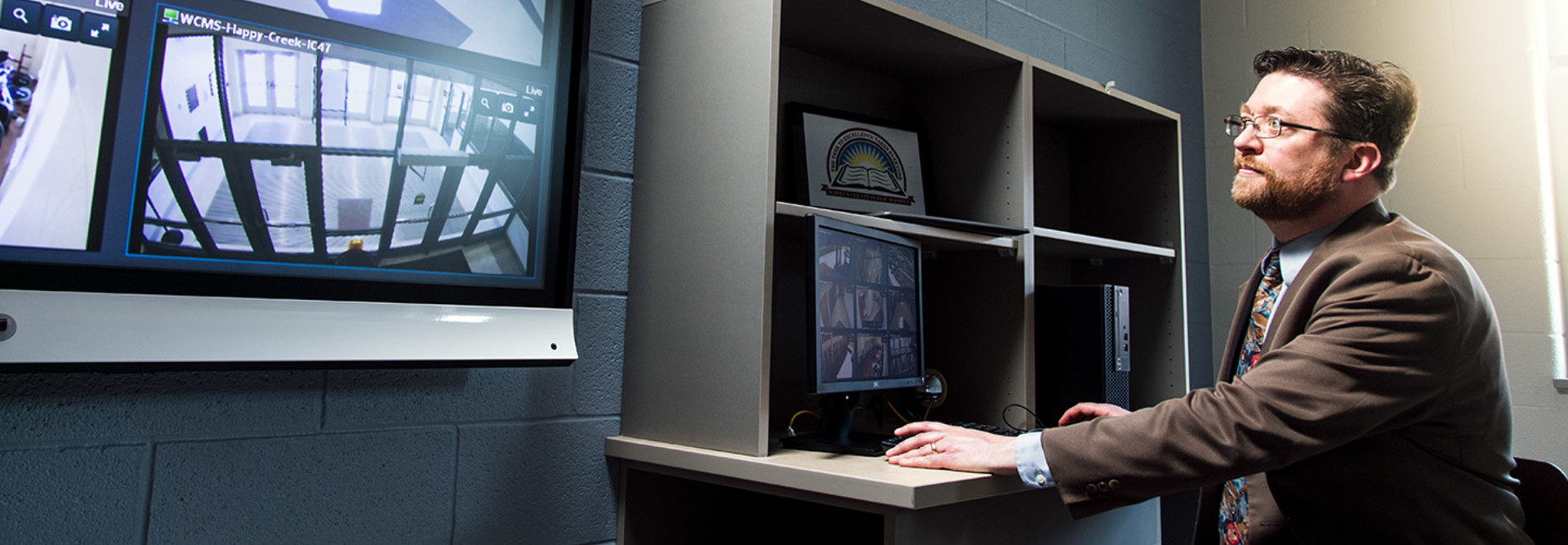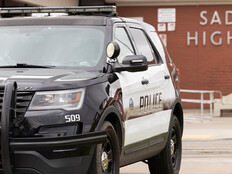Digital Surveillance Systems Help Keep K–12 Students, Staff Safe from Harm
Like many school districts across the country, Warren County Public Schools in Front Royal, Va., regards the safety of its students and staff as a top priority. Located an hour west of Washington, D.C., WCPS has 430 security cameras keeping a close watch on nine schools with about 5,000 students and 800 employees.
The district’s surveillance system not only allows school resource officers and administrators to monitor school grounds in real time, it also allows them to identify those involved in incidents after the fact, says Technology Director Timothy Grant.
“We had a break-in about four years ago, and we were able to identify the people who vandalized one of our schools,” Grant says. “Not all of our secretaries and administrative personnel have a clear view of the front door to see who’s coming in and who’s leaving, so having the monitors in the office is helpful.”
WCPS is among thousands of school districts that rely on school security measures like surveillance systems to keep students and staff safe in the wake of several highly publicized school attacks, starting with Columbine in 1999.
In 2014 — the last year for which data is available from the National Center for Education Statistics — 75 percent of public schools reported using security cameras to monitor their buildings. And a 2017 survey revealed that 70 percent of teachers felt cameras in the classroom might help prevent theft, vandalism and cheating.
Unified Video Capture Keeps Schools Secure Anytime
Until recently, each school in Warren County had its own camera system, some of which were feeding live streams to security monitors but weren’t capturing video for viewing later, says Grant.
A few years ago, the district began moving to a unified video capture system for all of its buildings. It’s currently replacing its aging Cisco Video Surveillance 2400 and 2600 IP cameras with newer Cisco 6000-series cameras. The district is also planning to install cloud-connected Cisco Meraki cameras at the Warren County High School football stadium.
Those cameras in turn are connected to a half dozen Cisco Connected Safety and Security UCS Platform Series C220 and C240 servers with nearly 200 terabytes of storage space.
And the district needs every bit of that, because its 430 cameras produce 864 gigabytes of video every single day. It recently upgraded its server storage to hold up to 30 days’ worth of video, which enables administrators to monitor activities over long school breaks.

“Keeping video for an entire month allows us to see if, say, someone drives into the high school football field over Christmas break and starts doing donuts on the turf,” Grant says.
The principal of each school determines where cameras are placed, following a few basic guidelines; for example, there are no cameras in classrooms or bathrooms, he says.
The biggest challenge is keeping up with the demand. Outfitting nine campuses with cameras and keeping them up to date takes awhile. This year WCPS is upgrading the cameras on half a dozen campuses.
“I’ve yet to meet a principal who’s said ‘Nope, I’ve got enough cameras, we’re done,’ ” says Grant. “Maybe we will get to that point, because there are constant upgrades and upkeep. But they help keep our kids, staff and faculty safe, so we want to continue to provide that in our environment.”
Cloud Connectivity Eases Management
Mount Vernon Independent School District, a 1,600-student district located about 100 miles northeast of Dallas, minimized the need for network storage and bandwidth by going with Cisco Meraki’s cloud-connected cameras.
The district first installed 25 Meraki cameras about two years ago, after voters approved a $14 million bond issue to fund the construction of a new sports facility and classrooms for the junior high school, says Technology Director Woodrow Thomas. When it came time to replace the 150 aging IP and analog cameras on its three campuses, Meraki was the first choice.
“We started out implementing a Meraki wireless network years ago, and then liked that so much we went with their firewall and then replaced all our switches with Merakis,” says Thomas. “So, when the chance came to replace our old cameras, it was the logical decision to look at Meraki.”
About 100 of the cameras have already been installed.
Because the new cameras are cloud-based, there’s no troublesome software to install to manage the video feed; administrators just call up a browser-based dashboard to view video on their computer or phone.
“So, in the case of an active shooter, someone off campus can monitor in real time what is going on in a building,” says Thomas.
A big advantage to Meraki, he says, is that video is stored on the cameras and only streamed across the network when users request it. Because the cameras don’t require a dedicated server or network storage, they’re easier to manage and consume far less network bandwidth than traditional IP cameras, says Thomas.
“The old system relied on DVRs,” he says. “Every cluster of 15 or 20 cameras had coaxial cable leading to some DVR stuck in a closet. It was a joy to leapfrog over this server-based IP camera system and into cloud-based camera technology. We do not have 150 cameras streaming video all the time back to a central location in the server room. When I ask to see a camera, Meraki sends the requests through the cloud to the camera, which streams the video directly to me on the local network.”

Photo by Justin Clemons
Each camera stores up to two weeks’ worth of footage, and Meraki’s smart search functions make it easy to review past events.
“We had a hit-and-run fender bender in the high school gym parking lot, and my school resource officer isolated the section of the lot where the car was parked,” Thomas says. “Meraki showed us every time there was motion in just that area of the screen. The SRO didn’t have to search through days and days of video.”
The key to picking the right system is making sure to understand how the cameras work and what kind of strain they can place on network resources, says Thomas. Then, it’s a matter of planning the cable runs and making sure to have enough Power over Ethernet switches and ports available.
The other big challenge? “Getting the funding,” Thomas says. “But once the principals, the resource officer and the superintendent got involved, the school board was willing to provide the money.”
Integrated Defense Systems Protect Holistically
As districts grow in size, so do their security needs. For example, Shawnee Mission School District, located just outside Kansas City, Kan., serves 27,500 students across 45 campuses: 34 elementary, five middle and six high schools.
In 2014, SMSD began installing Cisco 6000-series IP cameras across all of its schools as part of a $20 million investment in its integrated school defense system.
With up to 30 cameras per elementary school, between 40 and 50 for middle schools, and at least 120 for every high school, SMSD has in the neighborhood of 2,000 cameras — so many that the district dedicated a full-time person to maintain them, says Drew Lane, executive director of information and communication technologies.
The district uses the system for both real-time security monitoring and reviewing past incidents, Lane says.
“The beautiful thing is how the system can morph between those two purposes,” he says. “If you have a fight in a stairwell, you can review the video to see what took place, who the participants were and who was observing. If you have an intruder, you can use the camera in real time to track that person’s movements and direct law enforcement to their location.”
The technology isn’t the hard part, Lane says. The real challenge is knowing the right way to use it. That’s why the district hired a recently retired chief of police, John Douglass, to serve as its director of safety and security.
“You need to have a John Douglass on your team, someone with expertise in the field of physical security who can help you understand the best way to make use of your camera system,” Lane says. “Tech guys like me don’t necessarily think the same way or know the same things as a retired police chief. You need someone who understands those components of a security system.”









